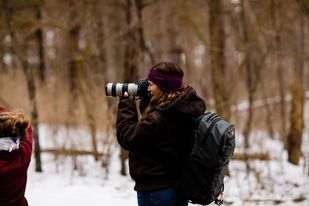5 Frequently Asked Photography Questions Answered
I get asked photography questions all the time, and I’m honored that people trust me to answer these questions for them! Today I am diving into my most frequently asked questions. This will be beneficial for you whether you have a SLR camera, or a super cool smartphone.

- What kind of camera should I buy?
You’re going to see a battle between the leading companies Nikon, Canon and Sony. To me its like Ford vs. Chevy. They all have state of the art technology, but people will have their preferences. To buy a great starter camera, I’d start with a $400 to $800 Canon or Nikon camera. (Learn about crop sensor vs. full frame.)
I stay where I’m comfortable- and that’s with Canon. That’s the camera I used to take photos for my high school yearbook and its also the camera I had access to during my college journalism days. It’s what I learned on. So I started with a Canon Rebel t5i back in 2013, and it helped me start Hannah Brecht Photography. Today I have a Canon 5d miii but am hoping to soon upgrade to a Canon mirrorless camera.
The thing to remember- once you invest in a SLR camera, you’re going to want to start building your lens collection. That’s where it can get REAL pricey. The lenses I recommend starting with are the 35, 50, or 85 mm lenses that match the brand of your camera.
2. What settings do you use?
This is such a broad question and it depends on each and every scenario. If you want to up your photography game, learn how to shoot in manual. Learn the exposure triangle- shutter speed, ISO, and aperture, and how they all affect each other. My college photography instructor once called the Auto mode “cheater mode” and that has stuck with me ever since.
It’s intimidating, I know! There are many free courses and videos on YouTube and Creative Live. I wasn’t 100% comfortable with my camera settings until I invested in Amy & Jordan’s online Shooting & Editing course. They are gifted educators and have an excellent way of breaking down difficult concepts. Click here for a free class with a discount!
3. What presets do you use?
Another thing Amy & Jordan’s Shooting & Editing Course taught me was how not to rely on presets. This cut my editing time in half. I purchased Lightroom presets from Twig and Olive Photography and Photoshop actions from Greater Than Gatsby. I use the presets to make my tones more consistent, and the actions help me a lot with retouching and enhancing.
Thats what presets and actions are meant to do- help enhance your photos, save time, and establish consistency. They shouldn’t be used to rescue a poorly taken photo. (But we’ve all been there and tried it anyway.)
Bottom line, you should first learn how to shoot and edit without presets or actions. Then spend some time looking at presets and actions that match the style you are going for. Greater Than Gatsby is a great place to start for both.
4. What tips do you have for new photographers?
Lighting is SO important! In my opinion, it’s more important than settings. This is truly what will make or break your images. There is so much to learn, but here are a few tips to start with. This can be helpful when shooting with either a phone or a camera.
Keep your subject evenly lit. Three ways to do this- if you’re outdoors, find open shade next to a building and have your subject stand in that shade. If you can’t find that, keep your subject’s back to the sun so that they see their shadow in front of them.
If you’re indoors, try to make your subject stand facing a window that will pour that nice natural light on them. Be sure not to block the light.
Avoid lens flare. This is when the sun hits your lens and creates a glare across the image. Yes, sometimes it looks artsy but you mainly want to avoid this until you’ve mastered basic lighting concepts. Use your hand or another object (tree, reflector, someone else) to block the sunlight from hitting your camera. If the object gets into frame, you can crop it out later.
5. When is the best time of day to shoot outdoors?
Golden hour. This is the hour after sunrise and the hour before sunset. Or I simply tell people to avoid the noon hour, when the sun is directly overhead. It’s so much easier to ensure even lighting when the sun is nice and low. And you might catch some gorgeous shots of the sky!
Lastly, I wanted to share my favorite photography learning resources! I am not a teacher, but these people are and I can say from experience that they are excellent at it!
Kirstie Marie Photography – KMPlearn.com
Amy & Jordan Demos – https://www.amyandjordan.com/
Justin Tedford, an excellent mentor- https://www.tedfordphoto.com/mentoring
Sue Bryce Education – https://suebryceeducation.com/
Join my VIP email list to stay up to date with my travel schedule, my work, seasonal discounts and more!
keep in touch!
Sign me up!